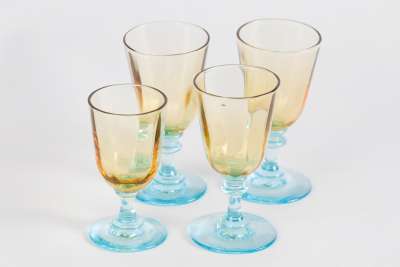The Charles Schneider Coupe is a captivating piece of early 20th-century glass artistry. Crafted in France, circa 1920, this coupe exhibits a harmonious blend of colours and form. The central section features light yellow glass, smoothly transitioning to a rim speckled with vibrant orange and violet hues, embodying the unique aesthetic for which Schneider glass is renowned. The piece is supported by a foot adorned in a distinct violet stripe pattern, showcasing the meticulous attention to detail characteristic of Charles Schneider’s work. The coupe is signed by Schneider, authenticating its origin and maker.
Condition Report
This Charles Schneider Coupe is in excellent condition, with no visible chips, cracks, or repairs. The glass retains its vibrant colours and clarity, indicative of careful preservation and handling over the years. The signature “Schneider” is clearly visible, confirming its authenticity and adding to its collectible value. The surface shows minimal signs of wear, consistent with its age, and the structural integrity of the piece remains intact. Collectors and connoisseurs will appreciate the pristine state of this antique, which has been expertly maintained to preserve its original charm and appeal.
Dimensions
Weight: 1522gm, Length: 30cm, Width: 30cm, Height: 18.3cm.
A Decorative Centrepiece for Any Table
The original intended use of the Charles Schneider Coupe was as an ornamental centrepiece, designed to decorate tables or display cabinets. Its vibrant colours and elegant form make it a striking focal point, perfect for adding a touch of historical elegance to any setting. The coupe’s design is both functional and decorative, allowing it to serve as a vessel for fruit or flowers while also standing alone as an art piece.
An Exemplary Piece of Art Deco Design
This coupe is a fine example of Art Deco design, a style known for its bold geometric patterns and vibrant colours. The interplay of light yellow with orange and violet hues reflects the period’s fascination with modernity and innovation. Art Deco emerged in the early 20th century, influenced by the rapid technological advances and cultural shifts of the time. The coupe’s dynamic colour palette and sleek form capture the essence of this movement, making it a valuable addition to any Art Deco collection.
The Craft of Schneider Glassmaking
The creation of this Charles Schneider Coupe involved a meticulous glassmaking process, combining traditional techniques with modern innovations. Schneider was known for his mastery of colour and form, using layered glass to achieve deep, vibrant hues and subtle transitions. The speckled effect around the rim was likely achieved through a technique known as “pâte de verre,” where glass powders are fused to create a textured finish. This method, along with the hand-applied violet stripes on the foot, highlights the artisanal skill involved in producing such a distinctive piece.
Crafted by Charles Schneider
Charles Schneider was a prominent French glassmaker whose work in the early 20th century significantly influenced the Art Deco movement. Known for his innovative use of colour and form, Schneider's pieces are highly sought after by collectors worldwide. His signature style often involved vibrant colour combinations and fluid shapes, as seen in this coupe. The signature “Schneider” marks this piece as an authentic example of his craftsmanship, showcasing his ability to blend artistry with functionality.
Collected by Enthusiasts of Art Deco Glass
Collectors are drawn to Charles Schneider’s works for their vibrant colours and unique forms, which encapsulate the spirit of the Art Deco era. This coupe, with its bold colour scheme and elegant design, is a testament to Schneider’s artistic vision and technical skill. Art Deco glassware, particularly pieces by renowned makers like Schneider, holds a special place in the hearts of collectors due to its historical significance and visual appeal. Such antiques offer a glimpse into the past, capturing the essence of a time when design was both an art and a statement of modernity.















